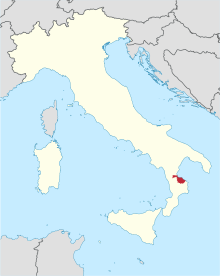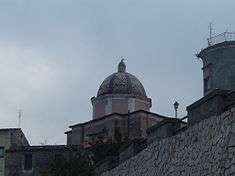Roman Catholic Archdiocese of Rossano-Cariati
| Archdiocese of Rossano-Cariati Archidioecesis Rossanensis-Cariatensis[1] | |
|---|---|
| Location | |
| Country | Italy |
| Ecclesiastical province | Cosenza-Bisignano[1] |
| Statistics | |
| Area | 1,415 km2 (546 sq mi) |
| Population - Total - Catholics |
(as of 2010) 137,500 135,000 (98.2%) |
| Parishes | 53 |
| Information | |
| Denomination | Catholic Church |
| Rite | Latin Rite |
| Established | 597[2] |
| Cathedral | Cattedrale di Maria SS. Achiropita (Rossano)[2] |
| Co-cathedral | Concattedrale di S. Michele Arcangelo (Cariati)[2] |
| Patron saints |
Maria Achiropita Nilo da Rossano Leonardo Abate Cataldo Vescovo[2] |
| Secular priests | 67[1] |
| Current leadership | |
| Pope | Francis |
| Archbishop | Santo Marcianò;[1] Rev. Fr. Giuseppe Satriano, V.G., is the Archbishop-designate |
| Map | |
 | |

The Italian Catholic Archdiocese of Rossano-Cariati (Latin: Archidioecesis Rossanensis-Cariatensis) in Calabria has existed since 597, beginning as the Diocese of Rossano. It is a suffragan of the Archdiocese of Cosenza-Bisignano.[1][2]
History
In 597, the Diocese of Rossano was established from the former Diocese of Thurio.[2]
In 982 Emperor Otto II captured Rossano temporarily from the Byzantines, who had made it the capital of their possessions in Southern Italy. It preserved its Greek character long after its conquest by the Normans.[3]
The first known bishop of this see is Valerianus, Bishop of the "Ecclesia Rosana" in the Roman Council of 680. Cappelletti, however, names a certain Saturninus as first bishop.[3]
In 1460, the Diocese was elevated to an Archdiocese[2] immediately subject to the Holy See.[1]
On Juni 27, 1818, with the bull De utiliori of Pope Pius VII, the dioceses of Cerenzia, Strongoli and Umbriatico were incorporated in the Diocese of Cariati.
The famous Codex Rossanensis was discovered in 1879 in the cathedral sacristy, see Batiffol (below).[3]
On February 13, 1919, the Diocese had territory transferred to create the Eparchy of Lungro for the Italo-Albanian Catholic Church.[2] On April 4, 1979, the Archdiocese was merged with the Diocese of Cariati to become the Archdiocese of Rossano e Cariati. On September 9, 1986, the Archdiocese was rename to Archdiocese of Rossano–Cariati[1] On January 30, 2001, the Archdiocese of Cosenza-Bisignano was elevated to a Metropolitan See with Rossano-Cariati as a suffragan diocese.[4]
Rite
In the tenth century, or perhaps earlier, the Greek Rite was introduced at Rossano, and continued until the sixteenth century, although two attempts were made to introduce the Latin Rite — once in 1092, and again by Bishop Matteo de' Saraceni in 1460. Priests of the Latin Rite, however, were often appointed bishops.[3] The Greek Rite was maintained especially by the seven Basilian monasteries in the diocese, the most famous of which was Santa Maria in Patiro. In 1571 the Greek Rite was abandoned in the cathedral, and half a century afterwards throughout the city.
Bishops
Among the prominent archbishops were:
- Juan Rodríguez de Fonseca (1519–1524), architect of the colonization of New Spain;
- Vincenzo Pimpinella (1525), nuncio to Germany;
- Giovanni Battista Castagna (1553), afterwards Pope Urban VII;
- Lucio Sanseverino;
- Pier Antonio Spinelli (1628) and Jacopo Carafa (1646), both of whom restored and embellished the cathedral.[3]
Ordinaries
Diocese of Rossano
Latin Name: Rossanensis
Erected: 7th Century
- Angelo (25 Feb 1429 – 9 Feb 1433 Appointed Archbishop (Personal Title) of Tricarico)
Archdiocese of Rossano
Latin Name: Rossanensis
Elevated: 1460
- Nicola Ippoliti (5 Sep 1481 – 13 Jan 1493 Appointed Archbishop (Personal Title) of Città di Castello)
- Giovanni Battista Lagni (18 Jan 1493 – 1500 Died)
- Bernardino López de Carvajal y Sande, Apostolic Administrator (10 Jan 1508 – 20 Jun 1519 Resigned)
- Juan Rodríguez de Fonseca (20 Jun 1519 – 12 Nov 1524 Died)
- Vincenzo Pimpinella (3 Jul 1525 – 3 Nov 1534 Died)
- Francesco Colonna (18 Dec 1534 – 22 Oct 1544 Appointed Archbishop of Taranto)
- Girolamo Verallo (14 Nov 1544 – 1551 Resigned)
- Paolo Emilio Verallo (22 Apr 1551 – 1 Mar 1553 Appointed Archbishop (Personal Title) of Capaccio)
- Giovanni Battista Castagna (1 Mar 1553 – Jan 1573 Resigned)
- Lancillotto Lancellotti (23 Jan 1573 – 1580 Died)
- Lelio Giordano (28 Nov 1580 – 1581 Died)
- Silvio Savelli (cardinal) (26 Jan 1582 – 1589 Resigned)
- Scipione Floccaro (17 Jul 1589 – 26 Sep 1592 Died)
- Lucio Sanseverino (2 Dec 1592 – 19 Nov 1612 Appointed Archbishop of Salerno)
- Mario Sassi (26 Nov 1612 – 9 Jan 1615 Died)
- Girolamo Pignatelli, C.R. (18 May 1615 – 22 Dec 1618 Died)[5]
- Ercole Vaccari (18 Feb 1619 – 27 Jul 1624 Died)
- Paolo Torelli (7 Oct 1624 – 1629 Resigned)
- Pietro Antonio Spinelli (28 May 1629 – 9 Dec 1645 Died)
- Giacomo Carafa (18 Oct 1646 – 7 Apr 1664 Died)
- Carlo Spinola, O.S.M. (15 Sep 1664 – 6 Jan 1671 Died)
- Angelo della Noca, O.S.B. (18 Mar 1671 – 14 Dec 1675 Resigned)[6]
- Girolamo Orsaja, O.M. (24 Feb 1676 – 13 Jun 1683 Died)[6]
- Girolamo Compagnone (5 Feb 1685 – 1 Nov 1687 Died)[6][7]
- Andrea de Rossi (archbishop), C.R. (31 May 1688 – 30 Oct 1696 Died)[6][8]
- Andrea Deodati, O.S.B. (1 Jul 1697 – 7 Aug 1713 Died)[6]
- Francesco Maria Muscettola, C.R. (6 Dec 1717 – 16 Apr 1738 Resigned)[6]
- Stanislao Poliastri (21 May 1738 – 30 Dec 1761 Resigned)
- Guglelmo Camaldari (29 Mar 1762 – 22 Apr 1778 Died)
- Andrea Cardamone (20 Jul 1778 – 29 May 1800 Died)
- Gaetano Paolo de Miceli, C.P.O. (29 Oct 1804 – 22 Oct 1813 Died)
- Carlo Puoti (6 Apr 1818 – 3 Jul 1826 Confirmed Archbishop (Personal Title) of Alife)
- Salvatore de Luca (9 Apr 1827 – 28 Apr 1833 Died)
- Bruno Maria Tedeschi (6 Apr 1835 – 19 Jan 1843 Died)
- Pietro Cilento (22 Jul 1844 – 21 Mar 1885 Died)
- Salvatore Palmieri, C.Pp.S. (24 May 1889 – 24 Nov 1891 Resigned)
- Donato Maria Dell'Olio (14 Dec 1891 – 5 Feb 1898 Appointed Archbishop of Benevento)
- Orazio Mazzella (24 Mar 1898 – 14 Apr 1917 Appointed Archbishop of Taranto)
- Giovanni Scotti (13 Dec 1918 – 16 Oct 1930 Died)
- Domenico Marsiglia (28 May 1931 – 20 May 1948 Died)
- Giovanni Rizzo (13 Jan 1949 – 18 Nov 1971 Retired)
- Antonio Cantisani (18 Nov 1971 – 31 Jul 1980 Appointed Archbishop of Catanzaro)
Archdiocese of Rossano e Cariati
Latin Name: Rossanensis et Cariatensis
United: 4 April 1979
- Serafino Sprovieri (31 Jul 1980 – 25 Nov 1991 Appointed Archbishop of Benevento)
- Andrea Cassone (26 Mar 1992 – 6 May 2006 Retired)
- Santo Marcianò (6 May 2006 – 10 Oct 2013 Appointed Archbishop of Italy, Military)
- Giuseppe Satriano (15 Jul 2014 – )
Diocese of Turio
The archdiocese includes the ancient Diocese of Turio (Thurii), a city which arose after the destruction of Sybaris; five of its bishops are known, the first being Giovanni (501) and the last Guglielmo (1170).[3]
See also
References
- 1 2 3 4 5 6 7 "Archdiocese of Rossano-Cariati" Catholic-Hierarchy.org. David M. Cheney. Retrieved February 29, 2016
- 1 2 3 4 5 6 7 8 "Archdiocese of Rossano-Cariati" GCatholic.org. Gabriel Chow. Retrieved February 29, 2016
- 1 2 3 4 5 6

- ↑ Cheney, David M. "Archdiocese of Cosenza-Bisignano". All Dioceses. catholic-hierarchy.org. Retrieved 5 January 2012.
- ↑ "Archbishop Girolamo Pignatelli, C.R." Catholic-Hierarchy.org. David M. Cheney. Retrieved November 24, 2016
- 1 2 3 4 5 6 Ritzler, Remigius; Sefrin, Pirminus (1952). HIERARCHIA CATHOLICA MEDII ET RECENTIORIS AEVI Vol V. Patavii: Messagero di S. Antonio. p. 335. (in Latin)
- ↑ "Archbishop Girolamo Compagnone" Catholic-Hierarchy.org. David M. Cheney. Retrieved August 8, 2016
- ↑ "Archbishop Andrea de Rossi, C.R." Catholic-Hierarchy.org. David M. Cheney. Retrieved August 8, 2016
Notes
- Cappelletti, Le Chieze d'Italia, XXI;
- Battifol, L'abbaye de Rossano (Paris, 1891)
- Gay, Les dioceses de Calabre a l'epoque byzantine (Macon, 1900)
![]()